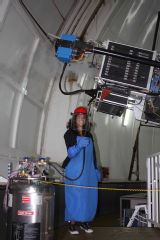Sandra Greiss
The detection of stellar remnants, as single or binary stars, can provide information on the final stages of stellar evolution. Their study can also offer an insight on the age of the different regions of our Galaxy, in which they are found. My PhD consists of two separate projects, with a main objective to develop methods to detect compact sources (white dwarfs, neutron starts, black holes) in our Milky Way. The most important tool used in my Phd is astronomical surveys. They provide all the information required to select compact object candidates for follow-up.
On one hand, the Chandra Galactic Bulge Survey (GBS) (Jonker et al., 2011) is crossmatched with the VISTA Variables in the Via Lactea (VVV) survey (Minniti et al., 2009), in order to find the near-infrared counterparts of 1640 unique Chandra X-ray sources detected in the Bulge. This region of the sky is extremely crowded and suffers from high extinction, which is why multi-wavelength observations of the X-ray sources is required to disentangle the effect of reddening and the selection of real matches can be more accurate. VVV is one of ESO's (European Southern Observatory) near-infrared public surveys. Near-infrared colours are insufficient to find the real exotic sources in the Bulge, which is why optical data of the Chandra Galactic Bulge Survey fields are required to distinguish the X-ray binary systems from the single active stars found in those fields. Combining VVV Ks-band variability and GBS optical data should help us find the real counterparts of the X-ray sources.
On the other hand, I have been involved in the calibration and release of the Kepler-INT Survey (KIS, Greiss et al. 2012). We have carried out a homogeneous Ugri and Hα survey of the Kepler field, down to ~20th mag in all five filters. All the observations are taken using the Wide Field Camera on the 2.5m Isaac Newton Telescope (INT) on the island of La Palma. NASA's Kepler mission (Borucki et al. 2010), launched in March 2009, delivers unprecedented time-series photometry of 116 deg2 region of the sky. Kepler's main goal is to find Earth-like planets orbiting Sun-like stars in their habitable zones. However, Kepler data is not only useful for the discovery of exoplanets but it also plays an important role in asteroseismology (the study of stellar pulsations, Charpinet et al. 2010), stellar activity (Basri et al. 2011), star spot monitoring (Llama et al. 2012), eclipsing and close binary systems (Prsa et al. 2011, Coughlin et al. 2011, Bloemen et al. 2011), gyrochronology (Meibom et al. 2011) and accreting white dwarfs (Fontaine et al. 2011, Still et al. 2010, Wood et al. 2011).
Due to the limits on the telemetry onboard the satellite, only ~170,000 stars can be observed at once. Therefore Kepler targets must be pre-selected before being observed. The main catalogue used up to the launch of the spacecraft to pre-select Kepler targets was the Kepler Input Catalog (KIC, Brown et al. 2011). However, this catalogue is only reliable down to 16th mag, i.e. the Kepler field lacked deep optical photometry. The rather shallow limiting magnitudes of KIC prevented the selection of white dwarfs and many other interesting and faint objects in the field. Therefore, we carried out the first deep optical survey of the field: KIS. Using the provided range of filters it is easy to select white dwarfs on the basis of their colours since they have bluer colours than main-sequence stars and most single white dwarfs also have Hα absorption. The observing strategy and data processing recipe are identical to those used by the European Galactic Plane Surveys consortium (IPHAS, Drew et al. 2005, UVEX, Groot et al. 2009, VPHAS+, Drew et al. in prep).
We began a search for white dwarfs, more precisely pulsating hydrogen-rich white dwarfs (ZZ Cetis), in the Kepler field to be able to make use of the quality of the uninterrupted data delivered by the Kepler satellite. We use KIS photometry to select ZZ Ceti candidates on the basis of their colours. Next we follow-up the candidates using ground-based time-series photometry and spectroscopy in order to check if they are variable sources and to confirm their identities. Obtaining good signal-to-noise spectra of our targets is essential to measure accurate temperatures and surface gravities, in order to determine whether they fall within the instability strip of ZZ Cetis (Gianninas et al. 2011). Using this selection method, we found nine new ZZ Cetis in the Kepler field. We are currently analysing the Kepler data we have for some of them.
The ultimate goal of both projects is to discover and study compact objects, whether single or in binary systems.

 Write to:
Write to: